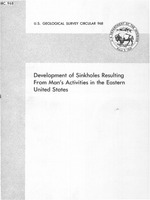Development of sinkholes resulting from man's activities in the Eastern United States
Links
- Document: Report (pdf)
- Download citation as: RIS | Dublin Core
Abstract
Development of induced sinkholes in carbonate terranes in the Eastern United States has resulted in costly damage and water pollution. Previously, detailed investigations of sinkholes were limited to Alabama and Missouri, with the most comprehensive being in Alabama. An investigation of the remainder of the area was made in 1981 to regionalize previous findings. More than 850 sites of sinkhole development have been identified in 19 States. It is estimated that more than 6,500 sinkholes or related features have formed at these sites. Most have occurred since 1950. Based on information available, States most impacted are Alabama, Florida, Georgia, Missouri, Pennsylvania, and Tennessee.
The total cost of damage and associated protective measures resulting from induced sinkholes is unknown. Costs reported for a limited number of sites were about $170 million--expended almost entirely after 1970. About $140 million were expended at five dams in four States and to repair or protect highways in two States.
Sinkholes are of two types, natural and induced {accelerated or caused by man}. The sudden development of both types results from the collapse of the roof of a cavity or cavern in rock, or from the downward migration of unconsolidated deposits into solutionally enlarged openings in the top of bedrock. The occurrence of sinkholes resulting from bedrock roof collapses, in comparison with the occurrence of sinkholes resulting from downward migration of unconsolidated deposits, is rare.
Induced sinkholes are of two types: those resulting from a decline in water level due to ground-water withdrawals and those resulting from construction. Sinkholes resulting from water-level declines are caused by loss of buoyant support, increase in velocity of water movement, water-level fluctuations, and induced recharge. Most induced sinkholes resulting from construction are caused by the diversion or impoundment of surface drainage over unconsolidated deposits resting on openings in the top of bedrock. Collapse mechanisms include loading, saturation, and piping.
Assessment of existing or potential sinkhole problems at a site requires recognition of features associated with sinkhole development and knowledge of triggering mechanisms that cause sinkholes. Natural sinkhole development is generally not predictable. Induced sinkhole development is predictable in some instances, but is predictable only in the sense that it will occur in a particular area. The most predictable development results from dewatering by wells, quarries, and mines.
Alternatives that allow avoiding or minimizing sinkhole hazards are most numerous when a problem or potential problem is recognized during site evaluation. The number of alternatives declines after the beginning of site development. Where sinkhole development is predictable, zoning of land use can minimize hazards.
Study Area
| Publication type | Report |
|---|---|
| Publication Subtype | USGS Numbered Series |
| Title | Development of sinkholes resulting from man's activities in the Eastern United States |
| Series title | Circular |
| Series number | 968 |
| DOI | 10.3133/cir968 |
| Year Published | 1987 |
| Language | English |
| Publisher | U.S. Government Print Office |
| Description | iv, 54 p. |
| Country | United States |
| Online Only (Y/N) | N |
| Additional Online Files (Y/N) | N |


